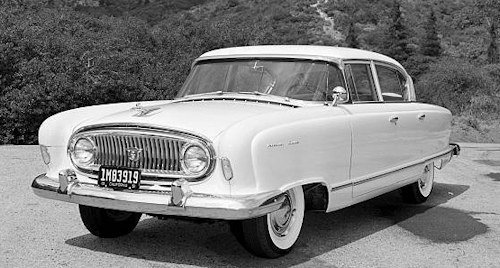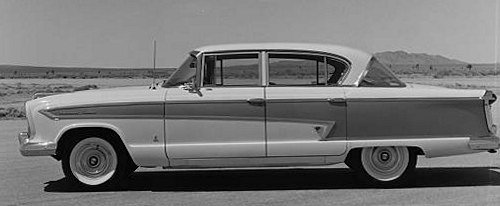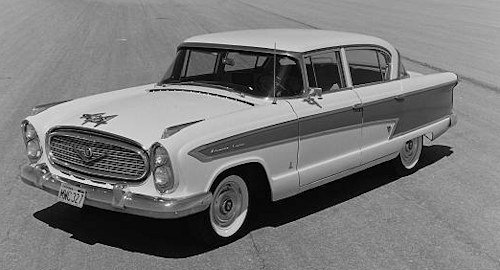Nash Ambassador 1952-1957
 |
|
|
Type |
motor car |
|
Body style |
2-door sedan ,4-door sedan ,2-door hardtop |
|
Layout |
Longitudinal front-engine, rear-wheel drive |
|
Engine |
|
|
Transmission |
|
|
Wheelbase |
121.25 in (3,080 mm) |
|
Length |
204.25 in (5,188 mm) |
|
Width |
78 in (2,000 mm) |
|
Height |
62.25 in (1,581 mm) |
The Nash Ambassador was last changed in 1952 .It received a complete restyle for that 50s look.
History
in 1952 Ambassador was available in "Super" and "Custom" series Standard with the Super Jetfire 4.1 L 252.6 cu in with 120 hp straight 6 engine.By 1953 the Ambassador received minor changes.
In 1954 there was only a small facelift. The Golden Anniversary Pininfarina Nash - designed by Pininfarina - has received several design awards. Because of the material shortage caused by the Korean War , the sales figures of Nash as well as those of other automakers in 1952 fell significantly. The 1954 Cheers between Fordand Chevrolet damaged many independent automakers, including Nash. The Airflytes launched in 1955 under Director Edmund E. Anderson vigorously redesigned in their last sales season. Panoramic windshields, who were walking around the A-pillars, showed themselves with brand-new vehicle fronts and backs that showed more from the front wheels than Nash had revealed since his 1949s. The Ambassador Super Jetfire was now 130hp and was now for the first time with the 5.2 L 320 cu in V8 engine that produced 120 hp. It came from Packard and was interlocked with the Packard Ultramatic automatic transmission.

Nash in 1956/1957offering a range of two- and three-color finishes. The 1957 models had double headlights as standard for the first time. While the Ambassador's styling might have suffered a bit, Nash could offer the car with the oft-announced "Weather Eye" heating and ventilation system, to which Nash's state-of-the-art air conditioning system could also be connected. Other automakers in the US also offered air conditioning in some models, but they had large boot-mounted relaxation units and heat exchangers that supplied air to the interior of the vehicle through clear plastic pipes and roof-mounted fans. Nash's air conditioning was cheap, space-saving and fitted under the hood.The V8 engine, a overhead valve type design with 327 cu in (5.4 L). It featured a forged steel crankshaft, and a 4-barrel carburetor.
Nash-Kelvinator merged with the adjoining Hudson Motor Car Co. in April 1954 and formed the American Motors Corporation(AMC). Both Nash and Hudson dealers now sold identical ramblers, which differed only by different logos. Likewise, the large model series of Nash and Hudson were resold, while the Rambler represented the new company in the lower market segment. As the Rambler's sales increased, so did the big Nash models, including the Ambassador.
The last Ambassador left the factory in Kenosha in the summer of 1957. Nevertheless, the name Ambassador still existed - as a term for the top models - at Rambler and AMC until 1974.

